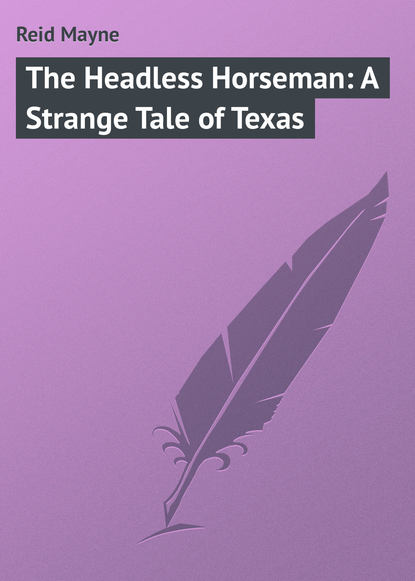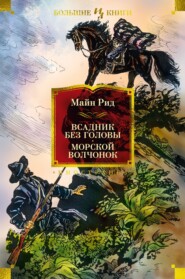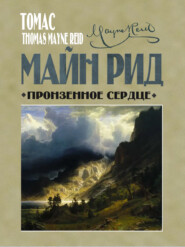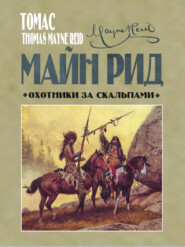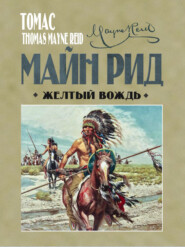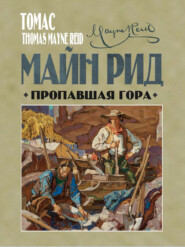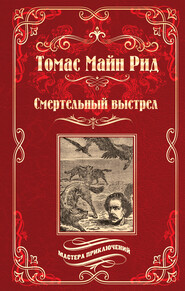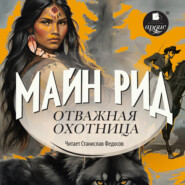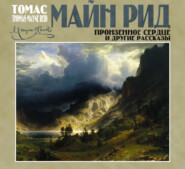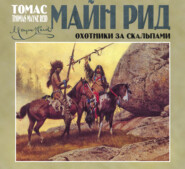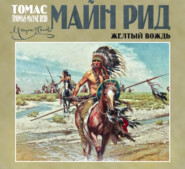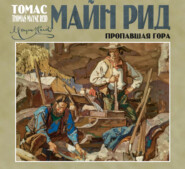По всем вопросам обращайтесь на: info@litportal.ru
(©) 2003-2024.
✖
The Headless Horseman: A Strange Tale of Texas
Настройки чтения
Размер шрифта
Высота строк
Поля
“Wal; thinkin’ as I did that the Irish wur innocent, I bekim detarmined to diskiver the truth. I ain’t goin’ to say thet appearances wan’t agin him. They wur dog-gonedly agin him.
“For all thet, I wan’t goin’ to rely on them; an so I tuk purayra to hev a squint at the sign.
“I knowd thur must be hoss-tracks leadin’ to the place, an hoss tracks goin’ from it; an damn ’em! thur wur too many o’ ’em, goin’ everywhur – else the thing mout a been eezy enough.
“But thar wur one partickler set I’d got a down upon; an them I detarmined to foller up to the eend o’ creashun.
“They war the footmarks o’ an Amerikin hoss, hevin’ three shoes to the good, an a fourth wi’ a bit broken off the eend o’ it. This hyur’s the eyedentikul piece o’ iron!”
The witness draws his hand from the pocket of his blanket coat, in which it has been some time buried. In the fingers are seen the shoe of a horse, only three quarters complete.
He holds it on high – enough for judge, jury, and spectators to see what it is.
“Now, Mr Judge,” he continues, “an’ you o’ the jury, the hoss that carried this shoe went acrosst the purayra the same night thet the murder war committed. He went arter the man thet air murdered, as well as him thet stans thar accused o’ it. He went right upon the track o’ both, an stopped short o’ the place whur the crime wur committed.
“But the man that rud him didn’t stop short. He kep on till he war clost up to the bloody spot; an it war through him it arterwards bekim bloody. It war the third hoss – him wi’ the broken shoe – thet carried the murderer!”
“Go on, Mr Stump!” directs the judge. “Explain what you mean by this extraordinary statement.”
“What I mean, judge, air jest this. The man I’m speakin’ o’ tuk stan’ in the thicket, from which stan’ he fired the shet thet killed poor young Peintdexter.”
“What man? Who was it? His name! Give his name!” simultaneously interrogate twenty voices.
“I reckon yu’ll find it thar.”
“Where?”
“Whar! In thet thur body as sits ’ithout a head, lookin’ dumbly down on ye!
“Ye kin all see,” continues the witness, pointing to the silent shape, “ye kin all see a red patch on the breast o’ the striped blanket. Thur’s a hole in the centre o’ it. Ahint that hole I reck’n thur’ll be another, in the young fellur’s karkidge. Thar don’t appear any to match it at the back. Thurfor I konklude, thet the bullet as did his bizness air still inside o’ him. S’posin’ we strip off his duds, an see!”
There is a tacit consent to this proposition of the witness. Two or three of the spectators – Sam Manly one of them – step forward; and with due solemnity proceed to remove the serapé.
As at the inauguration of a statue – whose once living original has won the right of such commemoration – the spectators stand in respectful silence at its uncovering, so stand they under the Texan tree, while the serapé is being raised from the shoulders of the Headless Horseman.
It is a silence solemn, profound, unbroken even by whispers. These are heard only after the unrobing is complete, and the dead body becomes revealed to the gaze of the assemblage.
It is dressed in a blouse of sky-blue cottonade– box plaited at the breast, and close buttoned to the throat.
The limbs are encased in a cloth of the like colour, with a lighter stripe along the seams. But only the thighs can be seen – the lower extremities being concealed by the “water-guards” of spotted skin tightly stretched over them.
Around the waist – twice twined around it – is a piece of plaited rope, the strands of horse’s hair. Before and behind, it is fastened to the projections of the high-peaked saddle. By it is the body retained in its upright attitude. It is further stayed by a section of the same rope, attached to the stirrups, and traversing – surcingle fashion – under the belly of the horse.
Everything as the accused has stated – all except the head.
Where is this?
The spectators do not stay to inquire. Guided by the speech of Zeb Stump, their eyes are directed towards the body, carefully scrutinising it.
Two bullet holes are seen; one over the region of the heart; the other piercing the breast-bone just above the abdomen.
It is upon this last that the gaze becomes concentrated: since around its orifice appears a circle of blood with streams straying downward. These have saturated the soft cottonade– now seemingly desiccated.
The other shot-hole shows no similar signs. It is a clear round cut in the cloth – about big enough for a pea to have passed through, and scarce discernible at the distance. There is no blood stain around it.
“It,” says Zeb Stump, pointing to the smaller, “it signifies nothin’. It’s the bullet I fired myself out o’ the gully; the same I’ve ben tellin’ ye o’. Ye obsarve thar’s no blood abeout it: which prove thet it wur a dead body when it penetrated. The other air different. It wur the shot as settled him; an ef I ain’t dog-gonedly mistaken, ye’ll find the bit o’ lead still inside o’ the corp. Suppose ye make a incizyun, an see!”
The proposal meets with no opposition. On the contrary, the judge directs it to be done as Zeb has suggested.
The stays, both fore and back, are unloosed; the water-guards unbuckled; and the body is lifted out of the saddle.
It feels stark and stiff to those who take part in the unpacking, – the arms and limbs as rigid as if they had become fossilised. The lightness tells of desiccation: for its specific gravity scarce exceeds that of a mummy!
With respectful carefulness it is laid at full length along the grass. The operators stoop silently over it – Sam Manly acting as the chief.
Directed by the judge, he makes an incision around the wound – that with the circle of extravasated blood.
The dissection is carried through the ribs, to the lungs underneath.
In the left lobe is discovered the thing searched for. Something firmer than flesh is touched by the probe – the point of a bowie-knife. It has the feel of a leaden bullet. It is one!
It is extracted; rubbed clean of its crimson coating; and submitted to the examination of the jury.
Despite the abrasion caused by the spirally-grooved bore of the barrel – despite an indentation where it came in contact with a creased rib – there is still discernible the outlines of a stamped crescent, and the letters C.C.
Oh! those tell-tale initials! There are some looking on who remember to have heard of them before. Some who can testify to that boast about a marked bullet – when the killing of the jaguar was contested!
He who made that boast has now reason to regret it!
“But where is he?”
The question is beginning to be asked.
“What’s your explanation, Mr Stump?” is another question put by the counsel for the accused.
“Don’t need much, I reck’n,” is the reply. “He’d be a durnationed greenhorn as can’t see, clur as the light o’ day, thet young Peint war plugged by thet ere bullet.”
“By whom fired, do you think?”
“Wal; thet appear to be eeqully clur. When a man signs his name to a message, thar’s no chance o’ mistakin’ who it kums from. Thar’s only the ineeshuls thur; but they’re plain enuf, I reck’n, an speak for theirselves.”
“I see nothing in all this,” interposes the prosecuting counsel. “There’s a marked bullet, it is true – with a symbol and certain letters, which may, or may not, belong to a gentleman well known in the Settlement. For the sake of argument, let us suppose them to be his – as also the ball before us. What of that? It wouldn’t be the first time that a murder has been committed – by one who has first stolen his weapon, and then used it to accomplish the deed. It is but a piece of ordinary cunning – a common trick. Who can say that this is not something of the same sort?”
“Besides,” continues the specious pleader, “where is the motive for a murder such as this would be – supposing it to have been committed by the man you are now called upon to suspect? Without mentioning names, we all know to whom these initials belong. I don’t suppose the gentleman will deny that they are his. But that signifies nothing: since there is no other circumstance to connect him in any way with the committal of the crime.”
“Ain’t thar though?” asks Stump, who has been impatiently awaiting the wind up of the lawyer’s speech. “What do ye call this?”
Zeb, on delivering himself, takes from his tinder-pouch a piece of paper – crumpled – scorched along the edges – and blackened as with gunpowder.





